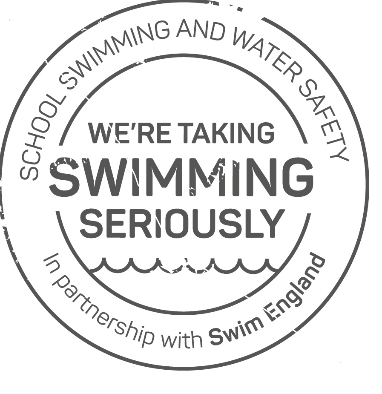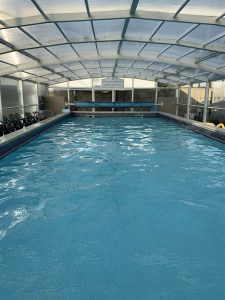One of the things that Engayne Primary School is most proud of is its indoor swimming pool. We are pleased to be able to offer all pupils on-site swimming lessons in line with the national curriculum. We believe that every child should have a positive, calm and safe environment to learn to swim. The children swim weekly from year 1 to year 6, all children swim regardless of their ability and our planning is inclusive of all.
In reception, typically, children gain water confidence; learn to float; put their face in the water and begin to swim. By year 6, we have built on their skills and techniques they will swim competently, confidently and proficiently over a distance of at least 25 meters. Use a range of strokes effectively (for example, Front crawl, Backstroke and Breaststroke)
Engayne Primary school are pleased to announce they have joined in partnership with Swim England, the national governing body for swimming, to help every one of their pupils become confident and capable swimmers.
| Award 1 | Award 2 |
| Pupils can complete these outcomes with or without floatation equipment or support | Pupils can complete these outcomes with or without floatation equipment: |
| Enter the water safely.Move forwards, backwards and sideways for a distance of 5 metres, feet may be on or off the floor.Scoop the water and wash face, be comfortable with water showered from overhead.Blow bubbles a minimum of three times rhythmically, with nose and mouth submerged.Take part in a movement game.Give examples of two pool rules.Recognise and identify the purpose of beach flags.Exit the water safely. | Enter the water safely.Move from a horizontal floating position on the front and return to standing.Move from a horizontal floating position on the back and return to standing.Push and glide on the front in a horizontal position, to or from the pool wall.Push and glide on the back in a horizontal position from the pool wall.Travel on the back for 5 metres.Travel on the front for 5 metres.Float on the back.Know how to signal for help.Exit the water safely. |
| Award 3 | Award 4 |
| Pupils can complete these outcomes without floatation equipment or support: | Pupils can complete these outcomes without floatation equipment or support: |
| Jump in from poolside and submerge (minimum depth of 1 metre).Fully submerge to pick up an object.Perform a tuck float and hold for five seconds.Push from wall and glide on the front with arms extended.Push from wall and glide on the back (optional with arms extended).Perform a rotation from the front to the back, then return to standing.Perform a rotation from the back to the front, then return to standing.Identify an open water hazard near your home or school.Exit the water safely. | Jump into the water, submerge, surface and swim back to the point of entry (minimum depth 1 metre).Push and glide towards the pool floor with arms extended.Perform a sequence of changing shapes (minimum of three) whilst floating on the surface.Push and glide on the front with arms extended and log roll onto the back.Push and glide on the back with arms extended and log roll onto the front.Travel 5 metres on the front, perform a tuck to rotate onto the back and return to the side.Travel 10 metres on the front with feet off the pool floor.Travel 10 metres on the back with feet off the pool floor.Perform a ‘shout and signal’ rescue. Explain how you would get help.Exit the water safely without using steps. |
| Award 5 | Award 6 |
| Pupils can complete these outcomes without floatation equipment or support: | Pupils can complete these outcomes without floatation equipment or support: |
| Jump into the water, submerge, surface and swim back to the point of entry (at least full reach depth).Perform a horizontal stationary scull on the back.Kick 10 metres backstroke.Kick 10 metres front crawl.Kick 10 metres butterfly or breaststroke on the front or on the back.Travel on back and log roll 180 degrees in one continuous movement onto front.Travel on front and log roll 180 degrees in one continuous movement onto back.Swim 10 metres, choice of stroke is optional.Give two examples of where it is safe to swim and why.Exit the water safely. | Perform three different shaped jumps into deep water (to include a straddle jump).Perform a head first scull for 5 metres.Two out of the following three must be completed:Swim 10 metres front crawl.Swim 10 metres backstroke.Swim 10 metres breaststroke.Tread water for 30 seconds.Perform a handstand or forward somersault, tucked in the water.Swim 25 metres (choice of stroke optional).Swim 10 metres wearing clothes – as a minimum t-shirt and shorts.Exit deep water without the use of steps. |
| Safe Self-Rescue | Aquatic Skills |
| Pupils can complete these outcomes without floatation equipment, in clothing and in the order listed without pause: | Pupils can complete these outcomes without floatation equipment or support: |
| Enter the water using a fall in entry.Float on the back or scull.Tread water for 20 seconds with one arm in the air and shout for help.Swim 15 metres on the front rotate and swim 15 metres on the back to a floating object.Take up the Heat Escape Lessening Position (H.E.L.P).Swim 10 metres retaining a floating object.Take up the Huddle position.Swim using a long arm front paddle (survival stroke) to the side.Climb out from water of at least full reach depth without using the steps. Discuss as a group when these skills might be used to self-rescue in different water based situations. | Enter the water safely.Submerge to pick up an object from the bottom of the pool (full reach depth).Swim 25 metres (choice of stroke is optional).Swim 50 metres (choice of stroke(s) may be used).Participate in a game of mini-polo.Discuss in your group the tactics and skills used and evaluate them.Perform a one-minute movement sequence in a group of three or more, incorporating a number of different skills, for example: sculling, treading water, floating, rotations.Exit the water safely. |



Swimming Standards end of 2023-2024 academic year
Swim England have now welcomed a new rule that requires schools to publish their swimming attainment levels.
There are three main swimming outcomes that children should achieve by the time they leave Engayne Primary School/Year 6.
- They must be able to swim competently, confidently and proficiently over at least 25 meters.
- They must be able to use a range of strokes effectively (front crawl, backstroke, breaststroke).
- They must be able to perform a safe self-rescue in different water based situations.
Below is a table showing the percentage of Year 6 students from 2023-2024 who achieved these three outcomes:
| Outcome: | Percentage: |
| What percentage of Year 6 students are able to swim competently, confidently and proficiently over at least 25 meters? | 97% |
| What percentage of Year 6 students are able to use a range of strokes effectively (front crawl, backstroke, breaststroke and butterfly)? | 95% |
| What percentage of Year 6 students are able to perform a safe self-rescue in different water based situations? | 99% |
Booster lessons are also taught at Engayne for pupils who need a little extra support with their swimming/certain skills and techniques. The number of children in each booster lesson is a lot smaller than a normal class, usually no more than 8 children.
The booster lessons are aimed at ensuring that children are getting the best chance to achieve the above three outcomes as possible before moving onto secondary school. The children who completed a term of booster lessons went on to achieve the year 6 requirements.
